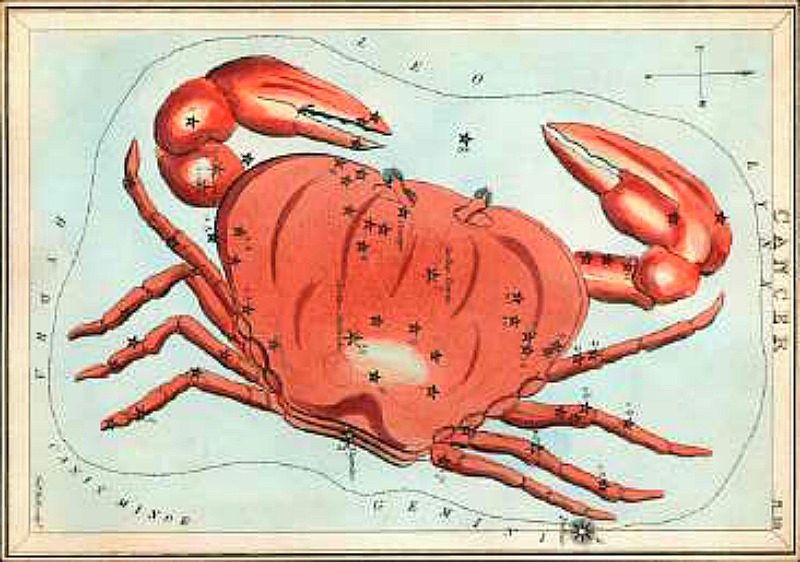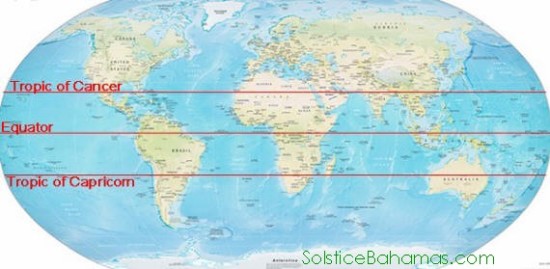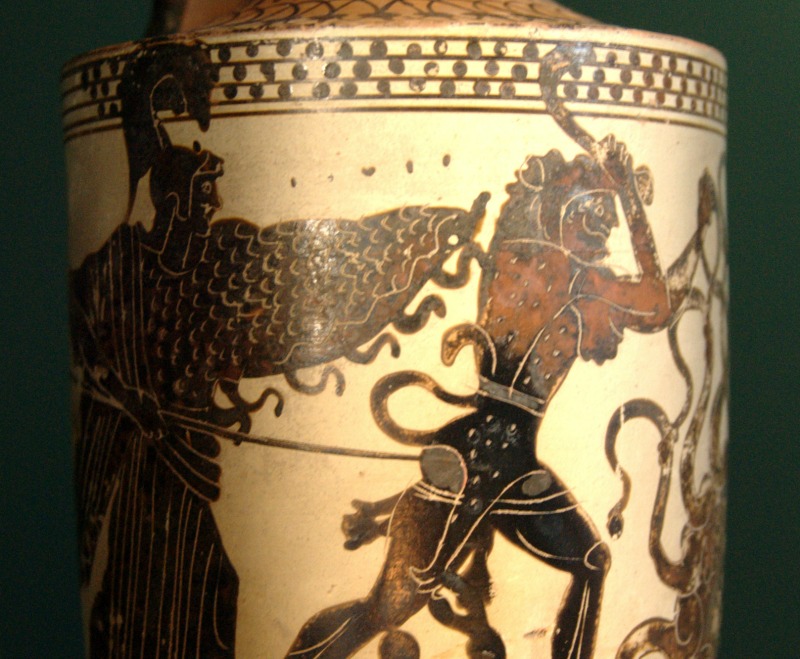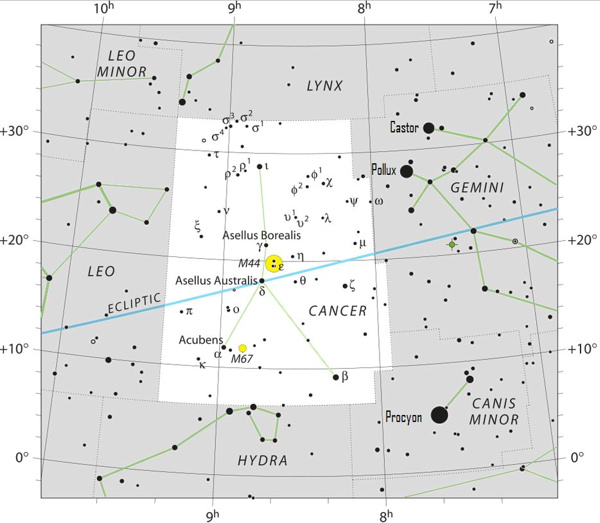

Image via Wikipedia
Chances are you’ve never seen Cancer the Crab, the faintest of the 13 constellations of the zodiac. Cancer the Crab may be found between the two brightest stars of Gemini (Castor and Pollux) and Leo’s brightest star (Regulus).
Links to posts about other constellations of the zodiac
Dates of sun’s entry into each constellation of the zodiac
How to find the constellation Cancer. In the Northern Hemisphere, Cancer is best seen in the evening sky in late winter and early spring. It is lost in the sun’s glare in July and August, and then is found in the morning sky starting in September. If you’re up before dawn during a Northern Hemisphere autumn, try finding Cancer and its Beehive star cluster.
Let’s suppose you have identified the Leo star Regulus, and the Gemini stars Castor and Pollux – and you look between them for Cancer and see, well, nothing much. Remember, Cancer is faint. Our advice is to look for it in a dark country sky.
Cancer is always well placed for viewing in March, and it is also well placed for evening viewing in April and May. It starts to descend into the sunset glare in June.
In early March every year, look for the constellation Cancer to be due south and highest up in the sky around 10 p.m. local time. (From the tropics, Cancer shines high overhead, and from temperate latitudes in the Southern Hemisphere, Cancer appears due north.) Because the stars return to the same place in the sky about four minutes earlier each day, or one-half hour earlier weekly, look for Cancer to be highest in the sky in mid-March at 9 p.m. local time (10 p.m. local daylight saving time). By late March or early April, Cancer reaches its high point for the night at 8 p.m. local time (9 p.m. local daylight saving time).
On a moonless night, Cancer is surprisingly easy to see in a dark country sky. You can locate the Crab’s place on the Zodiac by referring to certain zodiacal stars. The two brightest stars in the constellation Gemini, Castor and Pollux, shine on one side of Cancer, while Regulus, the brightest star in the constellation Leo, lies on the other side.

Mars was near the Beehive star cluster (M44) in April 2010. Mars is the bright reddish object in the upper left of this beautiful image by Peter Wienerroither. Used with permission.

View larger. | The bright planet Venus was near the Beehive star cluster in September 2012. The Beehive is the graceful grouping of stars on the left. Photo via Ken Christison.
Cancer’s famous Beehive star cluster. Cancer makes up for its lackluster stars by having within its boundaries one of the sky’s brighter star clusters, the Beehive cluster, also known as M44. Another name for the Beehive is Praesepe (Latin for “manger”).
In a dark sky, the Beehive looks like a tiny faint cloud to the unaided eye. As seen through ordinary binoculars, this nebulous patch of haze instantly turns into a sparkling city of stars. It is an open cluster, one of the nearest to our solar system. The Beehive is thought to contain a larger star population than most other nearby clusters.
The Beehive’s stars appear to be similar in age and proper motion to stars of the V-shaped Hyades open star cluster. It’s possible the two clusters were born from two parts of a single vast cloud of gas and dust in space.
Read more: 1,000 stars in the Beehive star cluster

The sun shines directly overhead at noon, as seen from those located along the Tropic of Cancer, at the Northern Hemisphere’s summer solstice. Image via solsticebahamas.com.
Significance of constellation Cancer. Cancer’s stature as a constellation of the zodiac has remained steadfast over the millennia. Over two thousand years ago, the sun shone in front of the constellation Cancer during the Northern Hemisphere’s summer solstice. That’s not the case today, however.
Today, the sun resides in front of the constellation Taurus when the summer solstice sun reaches its northernmost point for the year on or near June 21.
Nonetheless, Cancer still seems to symbolize the height and glory of the summer sun. To this day, we say the sun shines over the Tropic of Cancer – not the “tropic of Taurus” – on the June solstice. That’s in spite of the fact that the sun in our time passes in front of the constellation Cancer from about July 21 until August 10.
Dates of sun’s entry into each constellation of the zodiac
Nowadays, the sun doesn’t enter the constellation Cancer until about a month after the Northern Hemisphere’s summer solstice.

Hercules attacked by Karkinos (bottom) and the Lernaean Hydra, under the aid of Athena. White-ground Ancient Greek Attic lekythos, ca. 500–475 BC. Louvre Museum, Paris. Image via Wikipedia.
Cancer in history, myth and science. According to Richard Hinckley Allen, in his book Star Names: Their Lore and Meaning, astrologers call Cancer the House of the Moon from the early belief that the moon was located here at creation.
In astrology, the moon is said to rule Cancer. Astrology differs from astronomy in that astrologers assume positions of heavenly bodies have certain influences over human affairs. Astronomers generally regard the supposed connections as unfounded and view astrology as a pseudo-science.
Interestingly enough, however, modern-day astronomers believe the sun might have originated from Cancer’s fainter star cluster, Messier 67, though this study seems to throw cold water on the idea. Still, it looks as if Cancer may be the home of a creation story in both astrology and astronomy.
In ancient Chaldean and Platonic philosophy, Cancer was called the Gate of Men. It was through this portal that souls descend from the heavens above and into the bodies of the newly born.
Around 2700 years ago, the sun passed in front of the Beehive cluster on the Northern Hemisphere’s summer solstice. Back then, this cluster stood at the apex of the Zodiac, so perhaps it was this heavenly nebulosity that marked the Gate of Men. At present, the sun has its annual conjunction with the Beehive cluster in late July or early August.
In olden times, before the advent of light pollution, the ancients referred to the Beehive as the Praesepe (“little cloud”). The Roman author Pliny reports that when the Praesepe is invisible in an otherwise clear sky, it’s a sure sign of impending storm. Yes, the Beehive cluster once served as a celestial weather station.
Although Cancer may be the faintest constellation of the Zodiac, its legacy remains intact. On a dark, moonless night, look for Cancer’s faint grouping of stars to spring out in between the more conspicuous constellations Gemini and Leo.
Taurus? Here’s your constellation
Gemini? Here’s your constellation
Cancer? Here’s your constellation
Leo? Here’s your constellation
Virgo? Here’s your constellation
Libra? Here’s your constellation
Scorpius? Here’s your contellation
Sagittarius? Here’s your constellation
Capricornus? Here’s your constellation
Aquarius? Here’s your constellation
Pisces? Here’s your constellation
Aries? Here’s your constellation
Birthday late November to early December? Here’s your constellation
Bottom line: Looking for the constellation Cancer? How to find it in your sky.
Source:
https://earthsky.org/astronomy-essentials/cancer-heres-your-constellation
